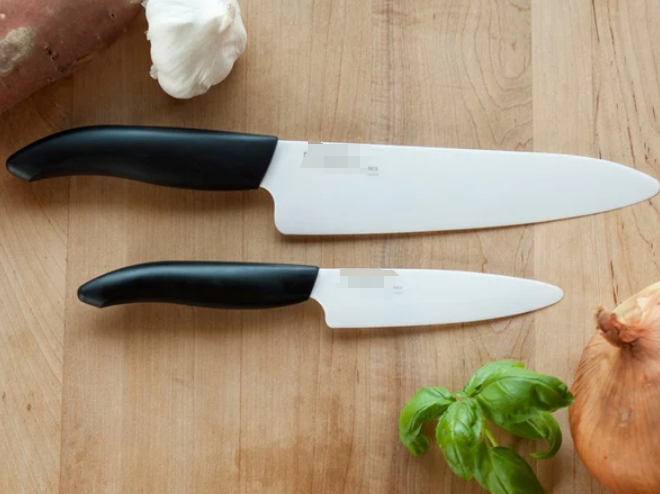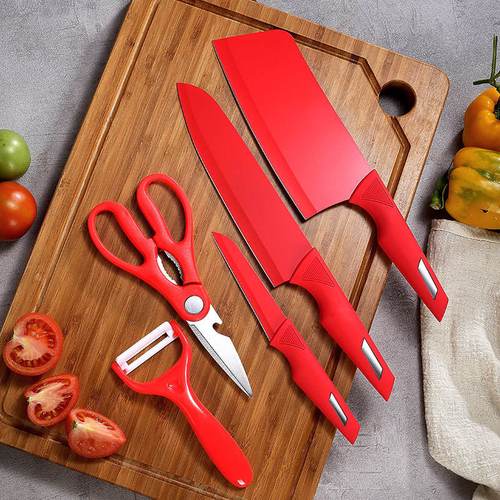

Views: 222 Author: Ella Publish Time: 2025-04-27 Origin: Site








Content Menu
● Origins and Cultural Background
● Usage and Cutting Techniques
● Frequently Asked Questions (FAQ)
>> 1. What are the main differences between Western and Japanese chef knives?
>> 2. Which knife is better for beginners?
>> 3. Can Japanese knives be used for chopping bones?
>> 4. How should I maintain my Japanese chef knife?
>> 5. What is the difference in sharpening angles between the two types?
Choosing the right chef's knife is essential for any cook, whether professional or home-based. Western and Japanese chef knives are the two dominant styles, each with unique characteristics shaped by their cultural origins, materials, and intended uses. This comprehensive article explores the differences between Western and Japanese chef knives, covering blade design, steel type, handle construction, sharpening, maintenance, and usage. We will also include relevant images and videos to illustrate these points and conclude with a FAQ section to address common questions.

Western chef knives evolved primarily in Europe, especially France and Germany, during the 18th and 19th centuries. The modern Western chef's knife is closely linked to the rise of professional chefs and restaurant culture, notably influenced by French chef Marie-Antoine Carême. These knives were designed to be versatile, durable, and suitable for heavy-duty kitchen tasks like chopping large quantities of vegetables and cutting meat with bones[1][5].
Japanese knives have a much older heritage, dating back over a thousand years, deeply intertwined with traditional craftsmanship and culinary culture. The art of Japanese knife-making shares techniques with samurai sword-making, emphasizing precision and sharpness. Japanese knives were designed to meet the delicate requirements of Japanese cuisine, such as slicing fish for sushi and sashimi with minimal damage to the ingredients[6][12].
- Blade Shape: Western chef knives typically have a curved blade edge with a pronounced belly, allowing a rocking motion for chopping herbs and vegetables.
- Thickness: The blade is generally thicker and heavier, providing durability for tougher tasks like cutting through bones or dense vegetables.
- Bevel: Usually double-beveled (sharpened on both sides), making them symmetrical and versatile for right- and left-handed users.
- Blade Length: Commonly 8 to 10 inches, balancing control and cutting surface[1][3][14].
- Blade Shape: Japanese knives tend to have straighter edges with less curvature, favoring slicing and push-cutting motions rather than rocking.
- Thickness: Thinner and lighter blades, allowing for precise, delicate cuts.
- Bevel: Many Japanese knives have a single bevel (sharpened on one side only), especially specialized knives like the Yanagiba or Deba, enabling ultra-fine cuts.
- Blade Length: Varies widely depending on type (e.g., Gyuto, Santoku, Nakiri), but often similar in length to Western knives, sometimes slightly shorter or longer depending on use[2][4][12][14].
- Steel Composition: Typically made from softer stainless steel or lower carbon steel alloys.
- Hardness: Rockwell hardness of about 52-58 HRC.
- Durability: Softer steel makes the blade tougher and less prone to chipping but requires more frequent sharpening.
- Maintenance: Easier to sharpen at home and more resistant to rust and corrosion[1][3][14].
- Steel Composition: Made from harder, high-carbon steel or layered Damascus steel.
- Hardness: Rockwell hardness ranges from 58 to 65 HRC.
- Edge Retention: Harder steel holds a sharper edge longer but is more brittle and prone to chipping.
- Maintenance: Requires careful sharpening, often on whetstones, and more delicate handling to avoid damage[1][12][20].

- Handle Style: Usually full tang with riveted handles made of synthetic materials or hardwood.
- Bolster: Often have a bolster (thick metal junction between blade and handle) for balance and finger protection.
- Grip: Ergonomic and heavier, offering a secure grip for heavy-duty cutting[2][18].
- Handle Style: Typically feature a wa-style handle made from wood or composite materials, often octagonal or D-shaped.
- Bolster: Usually lack a bolster, allowing the user to utilize the entire blade length.
- Grip: Lighter and slimmer, designed for precise control rather than brute force[2][12][18].
- Designed for versatility and durability.
- Ideal for chopping, mincing, dicing, and cutting through bones or frozen foods.
- Rocking motion is common due to curved blade.
- Suitable for heavier foods and tougher cutting tasks[2][3][18].
- Optimized for precision slicing and delicate tasks.
- Best for thin slicing of fish, vegetables, and boneless meats.
- Push-pull slicing technique preferred over rocking.
- Not recommended for chopping bones or frozen foods due to brittleness[8][10][20].
- Sharpened at a wider angle (~20-22 degrees).
- Easier to sharpen with common sharpening tools.
- Regular honing recommended to maintain edge.
- More resistant to corrosion and chipping[9][13].
- Sharpened at a narrower angle (~12-15 degrees), enabling sharper edges.
- Sharpening requires whetstones and skill to maintain single bevel edges.
- Must be hand-washed and dried immediately to prevent rust.
- Stored carefully to avoid chipping; not dishwasher safe[9][13][20].
Both Western and Japanese chef knives offer unique advantages tailored to different cooking styles and preferences. Western knives excel in versatility, durability, and ease of maintenance, making them ideal for heavy-duty kitchen tasks and cooks who prefer a robust tool. Japanese knives, with their thinner, lighter blades and harder steel, provide unmatched precision and sharpness, perfect for delicate slicing and specialized culinary techniques.
Choosing between them depends largely on your cooking habits, the types of food you prepare, and your comfort with knife maintenance. Many professional chefs and enthusiasts keep both types in their kitchen to leverage the strengths of each.

Western knives are generally heavier, thicker, and made from softer steel with double bevels, designed for durability and versatility. Japanese knives are lighter, thinner, made from harder steel with single or double bevels, optimized for precision and sharpness[1][2][12].
Western knives are often recommended for beginners due to their durability, easier maintenance, and forgiving nature. Japanese knives require more careful handling and sharpening skills but reward with superior sharpness[3][20].
No, Japanese knives are more brittle due to harder steel and thinner blades, making them unsuitable for chopping bones or frozen foods. Western knives are better suited for these tasks[1][20].
Hand wash immediately after use, dry thoroughly, store safely to avoid chipping, and sharpen regularly with whetstones. Avoid dishwashers and cutting hard materials[13][20].
Japanese knives are sharpened at a narrower angle (around 12-15 degrees) for a sharper edge, while Western knives are sharpened at a wider angle (20-22 degrees) for durability and ease of maintenance[14][18].
[1] https://www.seriouseats.com/western-versus-japanese-style-chefs-knives-6751328
[2] https://kazsknifeonline.com.au/blogs/knife-knowledge-and-information-1/comparing-western-japanese-chef-s-knives
[3] https://www.curated.com/journal/3799000/an-expert-guide-to-western-chefs-knives
[4] https://www.teruyasu.net/knowledge/knife_type.html
[5] https://estateagentnetworking.co.uk/the-evolution-of-the-chefs-knife-from-ancient-tools-to-modern-masterpieces/
[6] https://www.history.co.uk/articles/the-history-of-japanese-knife-making
[7] https://oishya.com/journal/top-10-expensive-knives-world/
[8] https://www.youtube.com/watch?v=1L5PdZOdlUc
[9] https://www.youtube.com/watch?v=qNmk5SDN8lc
[10] https://www.youtube.com/watch?v=FDNNG9doFe4
[11] https://kireaji.ca/pages/questions-about-japanese-knife
[12] https://jikkocutlery.com/blogs/deba-filet-knife/japanese-vs-western-knives-differences
[13] https://www.souschef.co.uk/blogs/the-bureau-of-taste/how-to-care-for-your-kitchen-knife
[14] https://www.silverback-knives.com/fr/pages/japanese-knives-vs-western-knives
[15] https://www.newwestknifeworks.com/products/8-western-chef-knife
[16] https://japaneseknifecompany.com
[17] https://www.dalstrong.co.uk/blogs/chef-blog/all-you-need-to-know-about-the-japanese-cooking-knife
[18] https://knifewear.com/en-gb/blogs/articles/western-knives-vs-japanese-knives-a-primer
[19] https://www.nouko.co.uk/ready-to-ship-1/the-western-nbt85
[20] https://www.chuboknives.com/blogs/news/the-difference-between-japanese-and-western-knives
[21] https://zahocho.com/blogs/japanese-knife-101/japanese-knives-vs-western-knives
[22] https://www.reddit.com/r/chefknives/comments/jwi5mt/western_vs_eastern_knives/
[23] https://www.chuboknives.com/blogs/news/the-difference-between-japanese-and-western-knives
[24] https://www.cnet.com/home/the-difference-between-western-and-japanese-knives/
[25] https://www.knifeopedia.com/western
[26] https://www.musashihamono.com/blogs/knowledge-japanese-chef-knife/are-japanese-knives-worth-it-5-reasons-to-invest-in-a-japanese-knife
[27] https://hasuseizo.com/blogs/japanese-kitchen-knives/japanese-knives-vs-western-knives-key-differences-explained
[28] https://dreamofjapan.com/blogs/japanese-knife-stories/everything-you-need-to-know-about-the-history-of-japanese-knives
[29] https://sharpedgeshop.com/blogs/knives-101/japanese-knife-handles-vs-western-knife-handles
[30] https://www.koiknives.com/blogs/japanese-knives/santoku-vs-western-chef-knives
[31] https://us.santokuknives.co.uk/blogs/blog/types-of-japanese-knives-used-by-the-best-japanese-chefs
[32] https://thegourmethost.com/evolution-of-western-knives-in-history-for-beginners/
[33] https://www.communitycutlery.co.uk/collections/all-western-knives
[34] https://bernalcutlery.com/en-gb/collections/western-kitchen-knives
[35] https://www.boroughkitchen.com/collections/western-knives
[36] https://www.youtube.com/watch?v=SVQxm7lk148
[37] https://whattocook.substack.com/p/the-knife-skills-guide-video-tutorial?triedRedirect=true
[38] https://www.youtube.com/watch?v=FuGZv_G5FlM
[39] https://www.etsy.com/market/western_chef_knife
[40] https://www.gettyimages.com/photos/japanese-knife
[41] https://oishya.com/journal/western-vs-japanese-knives-with-chef-olivia-burt/
[42] https://www.youtube.com/watch?v=hWfb69zDdvQ
[43] https://www.youtube.com/watch?v=QbZzlspamVQ
[44] https://www.boroughkitchen.com/products/kai-shun-classic-chefs-knife
[45] https://www.curated.com/journal/3282000/an-expert-guide-to-western-knives
[46] https://www.korin.com/japanese-knife-faq
[47] https://santokuknives.co.uk/blogs/blog/japanese-knife-care-complete-chef-knife-care-guide
[48] https://oishya.com/journal/western-vs-japanese-kitchen-knife-types/
[49] https://sharpedgeshop.com/blogs/knives-101/the-japanese-knife-everything-you-need-to-know
[50] https://www.boroughkitchen.com/blogs/news/japanese-vs-western-knives-pros-cons-key-differences-explained
[51] https://www.kitchenknives.co.uk/know-how/guides/the-ultimate-guide-to-buying-japanese-kitchen-knives/
[52] https://madeincookware.com/blogs/knife-tips